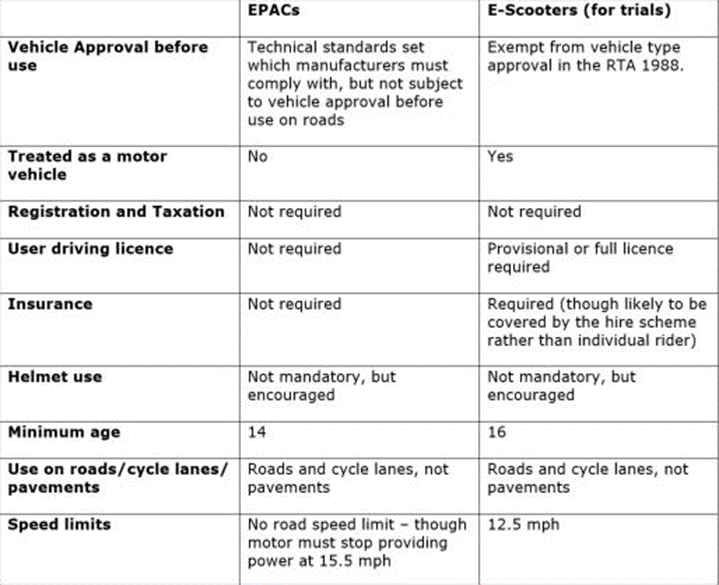Overview
This paper provides an overview of the use of E-Bikes and E-Scooters in Jersey, and the related policies and requirements.Introduction
There has been a rapid rise in the use of e-bikes in recent years, due to technological advances and lower prices – and indeed the impact of Covid-19 on working habits has accelerated this movement.
Many jurisdictions are seeking to promote the use of e-bikes and other low-powered electric vehicles to support sustainable transport policies and to reduce reliance on cars for everyday journeys.
Research has shown that e-bikes can have economic, environmental and/or personal health benefits, require less road space and consume less fossil-fuel, compared with traditional modes on a per person-trip basis.
The UK bicycle association report "The Case for a UK Incentive for e-bikes" published in July 2019 claimed that:
"The remarkable potential of e-bikes to replace a proportion of car trips, while maintaining or increasing physical activity levels for many of their users, gives them a critical role to play in the future of towns and cities. In several European countries support for e-bike purchase is now viewed as a valuable policy tool for reducing air pollution, traffic congestion and carbon emissions, with additional benefits for social inclusion."
E-Bike Use in Jersey
Transport emissions account for more than 50% of Jersey's direct greenhouse gas emissions. Road transport emissions alone accounting for more than 30% of Jersey's emissions. The States Assembly has endorsed the ambition of the Government of Jersey to achieve carbon neutrality by 2030. The Government's has committment to delivering the Sustainable Transport Policy to encourage changes in how Islanders travel by increasing cycling, walking and the use of sustainable transport; by delivering reductions in carbon emissions; and by increasing the level of protection afforded to the environment.
The Government has been supportive of moves towards alternative forms of transport including electric-powered cars and bicycles. In 2016, an electric bike grant scheme, named "car2cycle" was launched to increase cycling in Jersey by broadening the range of cycle users and using the e-bike as a car alternative. The scheme provided £300 per e-bike and ran from 2016 until the budget had been fully used in April 2017. The purchase of 550 e-bikes was subsidised via this scheme.
A follow up survey of e-bike grant recipients indicated that 52% of respondents purchased their e-bike with the intention of being more active/healthy, and 62% of respondents had replaced journeys formerly made in a car/van/scooter/motorbike with the e-bike. A subsequent e-bike grant scheme was launched in 2019 offering grants of £150 per e-bike – this scheme has now closed to new applicants.
A number of Island businesses offer on-demand electric transport services including e-bikes for hire on a short or long-term loan basis.
How do e-bikes work?
An e-bike (or Electrically Assisted Pedal Cycle) has a motor which can only provide assistance when the rider is pedalling. Sensors built into the system recognise when the rider is pushing on the pedals and provide power from the motor in proportion to the force of pedalling, so the bike cannot power the rider along without pedalling or cannot speed up uncontrollably.
By law, assistance from the motor must cut out at 15.5mph (25km/h) which is the same across the UK, EU and Australia (however, this limit rises to 20mph in the USA).
It is possible to ride an e-bike faster than 15.5mph, but the motor will cut out above this speed leaving the rider cycling under their own effort.
What are the laws on e-bikes?
An e-bike is defined as an electrically assisted pedal cycle (EAPC) under the Pedal Cycles (Jersey) Order 1998 (Article 2). This Order dictates that, in order to be legally ridden in Jersey, an EAPC must:
- have pedals that can be used to propel it;
- show either the power output or the manufacturer of the motor;
- show either the battery's voltage or the maximum speed of the bike;
- have an electric motor with a maximum power output of 250 watts;
- not have a motor able to propel the bike when it is travelling at more than 15.5mph (25kph); and
- if a separate throttle is fitted, it must not be capable of propelling the e-bike at more than 4mph when being peddled.
In January 2015 the UK made significant amendments to its "Electrically Assisted Pedal Cycle Regulations", to reflect Regulation (EU) No 168/2013 (the approval and market surveillance of two or three wheeled vehicles and quadricycles). This European regulation provided "improved conformity of production" to "ensure a high level of vehicle functional safety, occupational safety and environmental protection" primarily in L-category vehicles. These changes were necessary to keep pace with significant and rapid changes within the commercial pedal cycle market.
In May 2021, the Pedal Cycle (Jersey) Order 1998 was amended to match the legal requirements in both the UK and EU, so that compliant pedal cycles manufactured in other judications could be used in Jersey. This included making the following changes:
-
- the removal of a weight limit for either bicycles/tandems and tricycles;
- update to the reference to power output of the electric assistance motor;
- an increase to the maximum speed from 15mph to 15.5mph (25kph).
Electrically assisted pedal tricycles and cargo bikes that meet the criteria above are covered by the Pedal Cycle (Jersey) Order 1998 – however, other electrically powered two-wheeled vehicles such as e-scooters, Segways and larger cargo bikes do not meet the criteria set out in this legislation, and are either not currently permitted to be used on public roads.
Riding an e-bike
If an e-bike falls within the EAPC definition, legally it is treated like a regular, non-assisted bike. However, individuals must be at least 14 years old to be allowed to ride an electric bike. It is not currently necessary to register the e-bike and insurance is not mandatory. Helmet use is not legally required.
It is possible to ride an e-bike anywhere regular bike use is permitted, including on roads, green lanes and cycle lanes. As with a non-electric bicycle, riding on pavements is not permitted unless they are designated for mixed cycle and pedestrian use.
E-bike riders must obey the Jersey Highway Code, including observing stop signs and traffic lights.
E-Scooters
E-scooters are classed as motor vehicles in Jersey and are covered by the same laws and regulations that apply to all motor vehicles. As such, e-scooters would need to meet the different requirements (e.g. licensing, insurance, technical safety standards) of the relevant road traffic laws to use public roads lawfully. Currently, it is not possible to register e-scooters in Jersey - and it is not currently possible to obtain a licence or insurance for them. It is therefore only permissible to use e-scooters in Jersey on private property.
While it is legal to buy or sell an e-scooter in Jersey, riding them on public roads, pavements or cycle lanes is against the law.
As regards the general use of such devices on pavements or cycle tracks, Article 40 of the Road Traffic (Jersey) Law 1956 states that, subject to a number of exceptions, a person is liable to a fine if he/she drives a vehicle on any footway. This is supported by the Cycle Tracks (Jersey) Order 2000 which provides that only pedal cycles and pedestrians – on certain tracks – are allowed on cycle tracks.
The same rules apply to other electrically-assisted devices such as hover boards or e-skateboards, quad bikes, Segways, mini motos, mini choppers or TUK TUKs.
Are there plans to change the law on e-scooters?
Commenting on an e-petition to make a law for the safe use of electric powered transport devices a Government spokesperson stated that "new types of electric vehicles may be part of the solution, but only if they are safe for users, and are not a danger to other road users. There are no internationally recognised safety standards for these vehicles yet, and a lot of legislative work will have to be done before they can be driven legally in Jersey."
In the UK, it is possible to buy e-scooters for personal use, but they cannot be legally ridden on roads, cycle lanes or pavements unless the e-scooter is part of the new trials in which road and cycle lane use is permitted. Table 1 compares the rules in EPACs in the UK with those regulating the trials of e-scooters:

[Source: https://www.stewartslaw.com/news/e-scooter-uk-legalisation-and-regulation]
Globally, the rules on e-scooter regulation differ significantly - not all countries require insurance, for example, or a driving licence, and the variability of rules around registration, taxation and helmet use suggest that regulating e-scooter use is not straightforward.
The case studies below provide a sample of how other cities have different approaches to micromobility vehicles regulations:
- Berlin, Germany
Germany has regulated to allow 'small electric vehicles', which include electric scooters, to be used. These are limited to 12.5 mph (20km/h) and must have handlebars. Electric scooters may be used on the road or cycle lanes (where available), but not on the pavement. Users must have insurance and the vehicle must be registered, but a driving licence and helmet are not required.
- Tel Aviv, Israel
- Barcelona, Spain
E-scooters can use cycle lanes at speeds up to 10km/h (around 6 mph) and roads at speeds up to 30km/h (18.6mph) but cannot be used on pavements. They must be parked in designated spaces. The minimum age to use an e-scooter is 16. Users of e-scooters that are between 25-50kg and commercial users require helmets. Insurance is recommended, but not required.
[Source: https://www.stewartslaw.com/news/e-scooter-uk-legalisation-and-regulation]
How safe are e-scooters?
At present, reliable accident data on e-scooters is limited; however, data sources are developing as usage increases.
- The Parliamentary Advisory Council for Transport Safety recently released data showing that almost 300 injury-collisions on e-scooters occurred within the UK during 2021, of which nine were fatal and 91 involved serious injuries, including 31 head injuries. In the previous two years (2019 and 2020) there were three deaths.
- Henry Ford researchers looked at available data from the U.S. Consumer Product Safety Commission and found that between January 2009 and December 2019 there were more than 100,000 e-scooter related injuries reported. The study found that head and neck injuries made up nearly 28% of the total e-scooter related injuries reported.
- A British Medical Journal study of injuries relating to manual and electric scooter use between January 2016 and July 2019 confirmed that hospitals saw 468 scooter-related injuries during this period. Riders of electric scooters were likely to be 18-25 years old, sustain facial bruising and lacerations requiring sutures, and be under the influence of drugs or alcohol. Non-riders of electric scooters were mostly elderly people tripping over a scooter and sustaining an injury.
At present, the limited studies abroad demonstrate that e-scooters are not risk-free to either riders or pedestrians or other road users.

